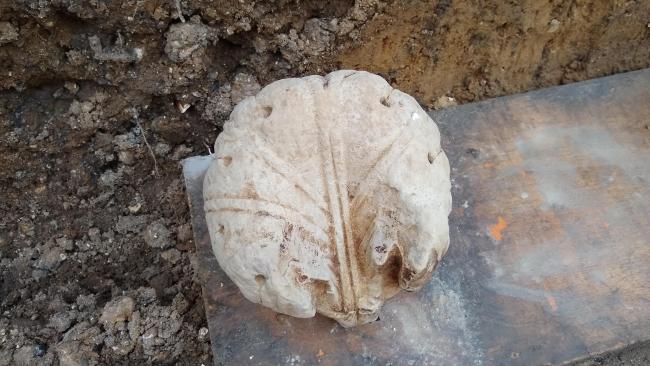
Newly discovered well gives further insight into Jesus College’s history
Archaeologists excavating Pump Court have unearthed a well believed to have supplied the pump that gave the court its name.
An ongoing archeological dig in Pump Court has uncovered a late medieval or early post-medieval well, within the remains of the hall designed by Alfred Waterhouse in 1875. Prior to 1875, the well would have stood in a courtyard just outside the kitchen and Great Hall of the College. This building was originally the refectory hall of the medieval nunnery that occupied the College site prior to 1496, and the well would have served as a source of water for both.
Archaeological evidence shows that at some point in the early College period, a brick-lined culvert was built to take water from the well into the storerooms and buttery beneath the Great Hall. When Waterhouse’s hall was constructed in 1875, the old well was incorporated into it. The 1888 Ordnance Survey map of Cambridge depicts a pump just outside the hall, presumably fed by the well. The court in which the well and pump were located has since become known as Pump Court.
Centuries of repair work make dating the well a complex challenge. College Archivist, Robert Athol, explained: "From the documentary point of view, the difficulty in dating the well comes from not having precise indications of which pump is being referred to in the early financial records. Often something like 'repair to pump' or 'putting lid on well' would be used but they didn't specify which pump or well, partly because, at the time, they knew which pump or well they were talking about!
"The archaeological evidence suggests that the origins of the well date to the very early part of the College history and that's where we have a gap in the documentary history of the College, so there's nothing, or very little, to refer to."
The well’s ‘construction cut’ (a pit which the well shaft was constructed inside), was dug through pits dating from the 12th–14th centuries. This suggests that it was built in the late medieval or early post-medieval period. The well shaft is made of chalk 'clunch' blocks, cemented together with a lime mortar. Its upper section is formed of reused limestone blocks, probably taken from an earlier building in the medieval nunnery.
This reuse of medieval stonework implies a late medieval nunnery or early post-medieval College date, when enough demolition and rebuilding work had taken place at the site to create a source of discarded stone for reuse in other structures. The use of clunch and limestone rather than brickwork in the original well shaft may be another indicator that the well was constructed during this period, before brick became more common.
The original stonework is full of brickwork patches dating from the 16th–19th centuries, showing that the well was repaired on numerous occasions. The effort put into maintaining it indicates that the well was in use over a long period, and valued as an important and reliable source of water. Its longevity is also evident from the thick lime scale crust on its eastern side, which developed due to repeated splashes by hard, calcium carbonate-bearing, water.
Cotswold Archaeology’s Preston Boyles said: “Upon excavating the interior of the well, we found a small number of 17th century finds (including a key!), but the general impression is that the well was regularly cleaned out and maintained, removing any evidence for earlier deposits, if indeed there were any earlier deposits.”
Documentary evidence from the College Archives indicates that the pump of Pump Court was removed shortly after the First World War. The well was filled in with rubble when Waterhouse’s hall was demolished in the early 1960s, ending its long history of use. Excavations through the 20th century backfill inside the well are still ongoing, but archaeologists hope to come across much earlier deposits at its base.





